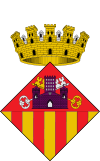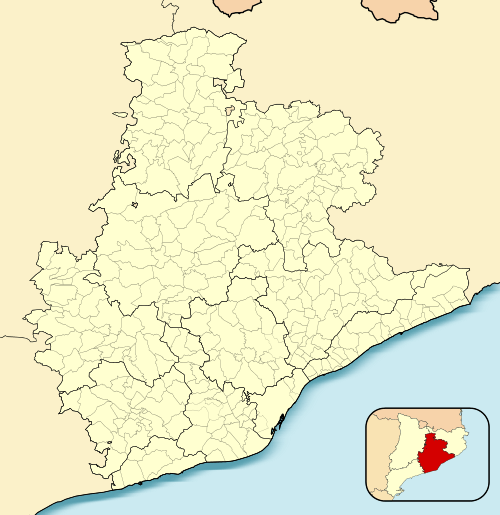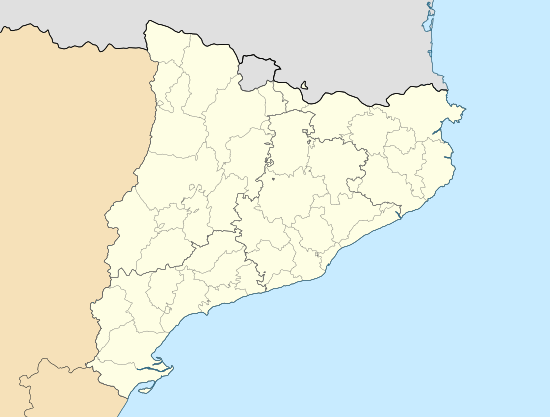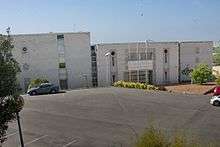Sant Cugat del Vallès
Sant Cugat del Vallès (Catalan pronunciation: [ˈsaŋ kuˈɣad dəl βəˈʎɛs]) (pop. 89,516 in 2017) is a town and municipality north of Barcelona in Catalonia, Spain. Known as Castrum Octavianum in antiquity (which literally means the castle of Octavianus) and as Pins del Vallès during the Second Spanish Republic, it is named after Saint Cucuphas, who is said to have been martyred on the spot now occupied by its medieval monastery. The final part of its toponym, del Vallès, is a reference to the historical county where the town is situated, Vallès.
Sant Cugat del Vallès | |
|---|---|
 | |
 Coat of arms | |
 Sant Cugat del Vallès Location in the Province of Barcelona  Sant Cugat del Vallès Location in Catalonia  Sant Cugat del Vallès Location in Spain | |
| Coordinates: 41°28′N 2°05′E | |
| Country | |
| Community | |
| Province | Barcelona |
| Comarca | Vallès Occidental |
| Government | |
| • Mayor | Mercè Conesa Pagés (2015)[1] (CiU) |
| Area | |
| • Total | 48.2 km2 (18.6 sq mi) |
| Elevation | 124 m (407 ft) |
| Population (2018)[3] | |
| • Total | 90,664 |
| • Density | 1,900/km2 (4,900/sq mi) |
| Demonym(s) | Santcugatenc |
| Website | santcugat |

Description
In addition to the monastery, the town's other notable buildings include the School of Architecture of the Vallès and the Centre d'Alt Rendiment (CAR, translit. High Performance Centre), a famous centre for professional sport training.
Sant Cugat has become an affluent suburb of Barcelona due to its location (only 20 kilometres from the city), its natural surroundings, and its pedestrian shopping area. Sant Cugat also offers restaurants, a concert venue, two cinemas, and one large shopping centre. It is also a political stronghold for conservative Catalan nationalism, with Convergència i Unió dominating the town's politics for 32 years up until 2019 when Esquerra Republicana de Catalunya took control of the City Council with the support of other political forces (PSC and CUP).
Sant Cugat has seen its population increase in recent years, with more births than bigger cities like Barcelona (2004). It has also practically merged with the nearby Rubí (population 72,987) and Cerdanyola del Vallès (population 58,747).
The town has its own train station with a direct metro connection into Barcelona city centre and the nearby industrial cities of Terrassa and Sabadell.
Main sights
These are some of the main sights of the municipality:[4]
- Monastery of Sant Cugat[5]
- Hermitage of Sant Medir (10th century)
- Hermitage of Sant Adjutori (10th century)
- Torre Negra (12th century)
- Gothic bridge of Can Vernet (14th century)
- Casa Armet
Demography
There are some districts, villages and towns in this municipality such as Mira-sol where 14,474 live; Valldoreix, which has a population of 8,272; La Floresta, whose population consists in 4,553 inhabitants and Les Planes, which is inhabited by 1,290 people.[6][7]
This table below show the population of the municipality during the 20th century and the early 21st century.
| 1900 | 1930 | 1950 | 1970 | 1986 | 2014 |
|---|---|---|---|---|---|
| 2,120 | 5,190 | 6,992 | 20,490 | 35,302 | 87,118[8] |
Government
National Archive of Catalonia is in the commune.
Education

The Japanese School of Barcelona, a Japanese international school, is located in the commune.[9] The Hoshuko Barcelona Educación Japonesa/Escuela de Educación Japonesa en Barcelona (バルセロナ補習校 Baruserona Hoshūkō), a weekend supplementary Japanese school, holds its classes in the Japanese School of Barcelona building.[10]
Culture
The town has a sardana club (Entitat Sardanista de Sant Cugat) that promotes this popular Catalan dance. A castellers club was formed in 1996.
See also
- Casa Lluch
References
- "Ajuntament de Sant Cugat del Vallès". Generalitat of Catalonia. Retrieved 2015-11-13.
- "El municipi en xifres: Sant Cugat del Vallès". Statistical Institute of Catalonia. Retrieved 2015-11-23.
- Municipal Register of Spain 2018. National Statistics Institute.
- "Sant Cugat heritage - Visit Sant Cugat. only 15 minutes from Barcelona". www.visitsantcugat.cat. Retrieved 2018-10-01.
- "Monastery of Sant Cugat, the best cloister in Europe. - Visit Sant Cugat". www.visitsantcugat.cat. Retrieved 2018-10-01.
- "Guia de Sant Cugat" (in Catalan). Retrieved 2018-10-01.
- "INEbase / Demography and population /Municipal Register. Population by municipalities /Nomenclature: Continuous Register Population by Population Unit / Results". www.ine.es. Retrieved 2018-10-01.
- "Ajuntament de Sant Cugat - Xifres". Santcugat.cat. 2015-09-28. Retrieved 2016-09-25.
- "バルセロナ日本人学校地図" (Archive) Colegio Japonés de Barcelona. Retrieved on 4 January 2014. "Can Graells 61, 08174, Sant Cugat del Valles, Barcelona, Spain"
- "TOPページ Archived 2015-01-12 at the Wayback Machine." Hoshuko Barcelona Educación Japonesa. Retrieved on February 15, 2015. "所在地 Camí de Can Graells, 61 Polígon Can Graells 08174 Sant Cugat del Valles Barcelona, Spain" and "バルセロナ日本人学校の校舎を借用し、授業を行なっています。"
Sources
- Panareda Clopés, Josep Maria; Rios Calvet, Jaume; Rabella Vives, Josep Maria (1989). Guia de Catalunya, Barcelona: Caixa de Catalunya; ISBN 84-87135-01-3 (Spanish); ISBN 84-87135-02-1 (Catalan).
External links
| Wikimedia Commons has media related to Sant Cugat del Vallès. |
- Government data pages (in Catalan)
_-_23.jpg)
.svg.png)